<< Previous | Displaying results 2876-2900 of 6772 for "" | Next >>
Soon after liberation, a British woman helps a camp survivor try on shoes. Bergen-Belsen, Germany, after May 1945.
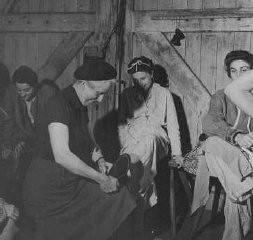
Jewish female survivors at a convalescent home. Sweden, 1946.
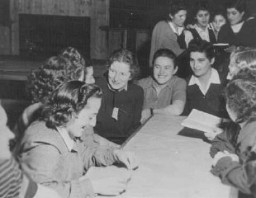
Jewish refugees, part of the Brihah (the postwar mass flight of Jews from eastern Europe), in a crowded boxcar on the way to a displaced persons camp in the American occupation zone. Germany, 1945 or 1946.
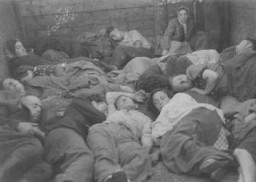
Children in the Bad Reichenhall displaced persons camp. Germany, 1945.
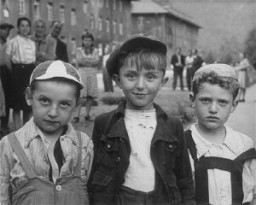
Jewish displaced persons in an ORT (Organization for Rehabilitation through Training) sewing workshop. Landsberg, Germany, between 1945 and 1947.

An ORT (Organization for Rehabilitation through Training) auto mechanics class at Landsberg displaced persons camp. This training prepared the students to emigrate to Palestine. Germany, postwar.
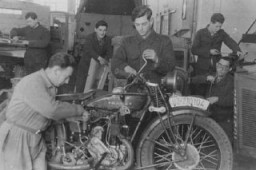
Refugees crowd the rail of the Aliyah Bet ("illegal" immigration) ship Josiah Wedgewood, anchored at the Haifa port. British soldiers transported the passengers to the Athlit internment center. Palestine, June 27, 1946.
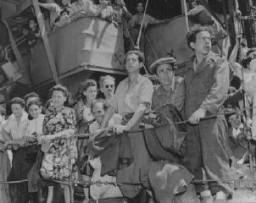
Polish Jewish refugees arriving at Babenhausen displaced persons camp, where the Joint Distribution Committee and the United Nations Relief and Rehabilitation Administration provided aid. Germany, August 20, 1947.
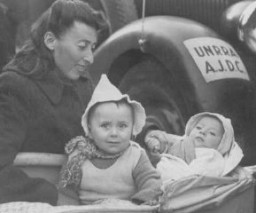
A class for new immigrants in the United States. Postwar.
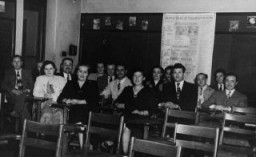
Soldiers from unidentified units of Einsatzgruppe C look through the possessions of Jews massacred at Babi Yar, a ravine near Kiev. Soviet Union, September 29–October 1, 1941.
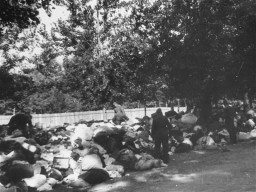
Roundup of the Jews of Lubny, shortly before they were massacred by Einsatzgruppe detachments. This photo, originally in color, was part of a series taken by a German military photographer. Copies from this collection were later used as evidence in war crimes trials. Lubny, Soviet Union, October 16, 1941.
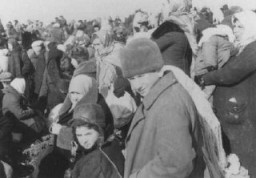
Ukrainian Jews who were forced to undress before they were massacred by Einsatzgruppe detachments. This photo, originally in color, was part of a series taken by a German military photographer. Copies from this collection were later used as evidence in war crimes trials. Lubny, Soviet Union, October 16, 1941.

Site where members of Einsatzgruppe A and Estonian collaborators carried out a mass execution of Jews in September 1941. Kalevi-Liiva, Estonia, after September 1944.
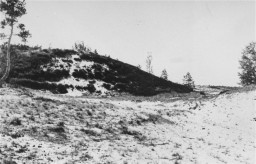
Soon after liberation, a Soviet physician examines Auschwitz camp survivors. Poland, February 18, 1945. This photograph is a still image from Soviet film of the liberation of Auschwitz.

This photograph taken soon after liberation shows young camp survivors from Buchenwald's "Children's Block 66"—a special barracks for children. Germany, after April 11, 1945.
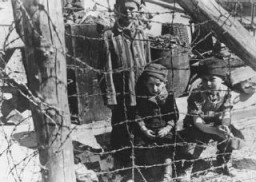
American radio journalists view corpses in the Buchenwald concentration camp. This photograph was taken after the liberation of the camp. Germany, April 18, 1945. Pictured from left to right are, Lowell Thomas (NBC); Howard Barnes (WOR); and George Hamilton Combs (WHN).
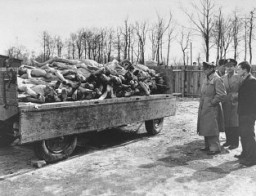
Liberated prisoners demonstrate the overcrowded conditions at the Buchenwald concentration camp. Photograph taken after the liberation of the camp. Buchenwald, Germany, April 23, 1945.
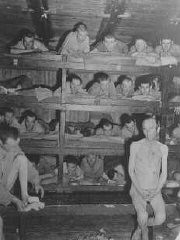
A mass grave at Bergen-Belsen soon after the liberation of the camp. Bergen-Belsen, Germany, May 1945.
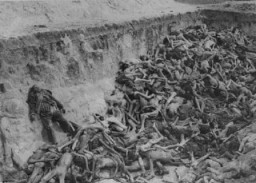
Soon after liberation, camp survivors cook in a field. Bergen-Belsen, Germany, after April 15, 1945. In the days before liberation, the prisoners had been left without food or water. More than 13,000 inmates died in the three months following liberation.
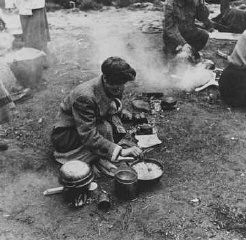
An survivor of the Bergen-Belsen camp, after liberation. Bergen-Belsen, Germany, after April 15, 1945.

US General Dwight D. Eisenhower and General Troy Middleton, commanding general of the XVIII Corps, Third US Army, tour the newly liberated Ohrdruf concentration camp. Ohrdruf, Germany, April 12, 1945.
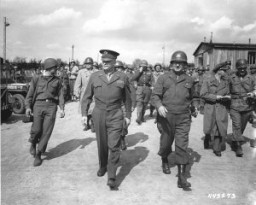
This camera equipment belonged to Walter Hunkler, a sergeant assigned to a medical detachment of the 160th Field Artillery Battalion, which entered Dachau on April 29, 1945. He took photographs documenting the camp and the prisoners found there.
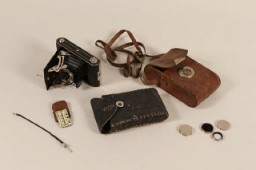
German soldiers in the Soviet Union during a December 1943 Soviet offensive on the eastern front. German troops invaded Soviet territory in June 1941 but faced counteroffensives following the battle of Stalingrad. December 16, 1943.
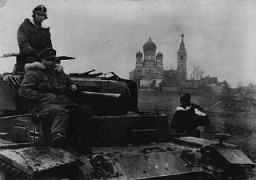
A German army column struggles through the mud, past a destroyed Soviet tank. Nevel, Soviet Union, fall 1943.
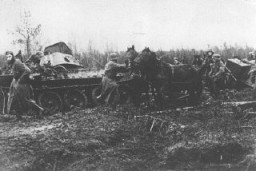
British troops land on the beaches of Normandy on D-Day, the beginning of the Allied invasion of France to establish a second front against German forces in Europe. Normandy, France, June 6, 1944.
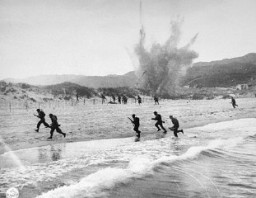
We would like to thank Crown Family Philanthropies, Abe and Ida Cooper Foundation, the Claims Conference, EVZ, and BMF for supporting the ongoing work to create content and resources for the Holocaust Encyclopedia. View the list of donor acknowledgement.